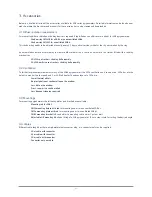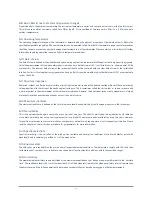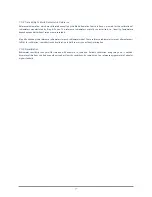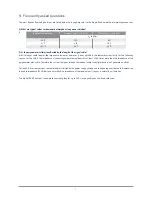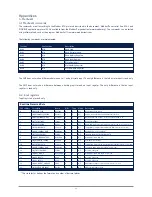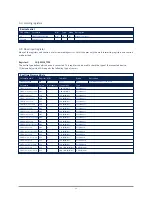
SGR pyrgeometers are simple to maintain and do not require any special tools or training. There are no service items requiring
scheduled replacement.
7.1 Daily maintenance
On clear windless nights the window temperature of horizontally placed radiometers will decrease, even to the dew point
temperature of the air, due to infrared radiation exchange with the cold sky. The effective sky temperature can be 30 °C lower
than the ground temperature.
Depending upon the weather conditions dew, glazed frost or hoar frost can be precipitated on the top of the window and can
stay there for several hours in the morning. An ice cap on the window is a strong diffuser and increases the pyrgeometer signal
drastically, up to 50 % in the first hours after sunrise. Snow may completely cover the window.
The frequency of cleaning is highly dependent upon the local weather and environmental conditions, such as dust, airborne
pollutants or salt spray in marine environments. Ideally, the window of the pyrgeometer should be cleaned every morning
before sunrise. The frequency of cleaning can be reduced by the use of a ventilation unit (less effective for SGR3), with the
heaters switched on when necessary.
Note
Clean the window using pure alcohol or distilled water and a lint-free cloth. Ensure that no smears or deposits are
left on the window.
7.2 Monthly maintenance
Check that the pyrgeometer is level and adjust if necessary.
Check that the sun shield is firmly clipped on.
7.3 Yearly maintenance
Check all the electrical connections. Unscrew the plugs, clean if necessary and then reconnect.
Check cables for damage caused by accident or by rodents.
Check the instrument mountings and any base supports are secure.
7.4 Calibration
An ideal radiometer gives an output that is proportional to the absolute irradiance level. This relationship can be expressed as
a constant ratio called ‘sensitivity’. SGR series pyrgeometers are very stable instruments, but they do change very slightly with
time. This is largely due to exposure of the black detector coating to UV solar radiation. Recalibration is recommended every
two years. Normally this is carried out at the Kipp & Zonen factory or at an authorised calibration facility.
.
7.4.1 Calibration principle
An ideal radiometer gives voltage output that is proportional to the absolute irradiance level. This relationship can be expressed
as a constant ratio called ‘sensitivity’ (Sensitivity).The sensitivity figure of a particular pyrgeometer is unique. In the case of the
SGR4 it is determined outdoors by comparison against a reference CGR4 pyrgeometer. The reference pyrgeometer is calibrated
outdoors regularly at the World Radiation Centre (WRC) at Davos, Switzerland.
Both the SGR3 and SGR4 have an accurate temperature sensor built in. This sensor measures the detector temperature. In the
SGR3 this temperature is used to correct for the average temperature dependency of all SGR3’s. The SGR4’s temperature depend-
encies are measured individually and corrected for. This same temperature is used to correct for the sensors own radiation and
calculate the downward radiation. Both L
net
and L
d↓
are available via the Modbus® interface. The analogue output gives L
d↓
by
default, but using the SmartExplorer software this can be changed.
7. Maintenance and recalibration
33





